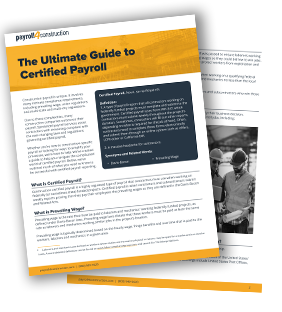Different Methods of Tracking PTO Accrual

May 31, 2022
The commercial construction industry is a finicky beast when it comes to time off. At one single job site, there may be seasonal workers, union workers, full-time workers, part-time workers, and trade workers from everywhere under the sun. Different classifications, all accumulating paid time off at different rates, levels, and times. See? Finicky.
Traditionally, the construction industry erred towards dividing employee time off into the categories of vacation time, sick time, and personal leave. Nowadays, with a renewed focus on recruitment and retention caused by a spike in commercial competition, the pendulum has swung more toward Paid Time Off or PTO. PTO is one conglomerated, singular bank of time that an employee can pull from and use as they wish.
Here’s the thing. PTO is not a generalized system — there are multiple ways in which it can be provided. So how do you go about selecting what will work best for your company as well as your employees? Let’s explore some of the options to see what might fit best for your business.
The First Method of PTO Tracking: Unlimited
Unlimited policies are a newer phenomenon in the construction industry, implemented by companies in search of a sharper competitive edge. New talent is attracted to unlimited policies because they view it as a symbol of trust between themselves and their employers, and they enjoy the added agency it encourages. Trusted employees tend to demonstrate more loyalty to their company and perform at a higher efficiency level, increasing overall profitability. The policy itself is easy to manage and isn’t heavy on the budget because there is no vacation payout whenever an employee quits.
So why are unlimited policies not favored amongst contractors? The risk of abuse. If a limit isn’t set and absences pile up, the company then runs into potential delays at the job site. Delays can lead to deadlines missed, and of course, deadlines missed can lead to both financial loss and damage to reputation.
The Second Method of PTO Tracking: Allotment
Allotted PTO policies provide the employee with a specific amount of time that can be applied as paid time off in whatever way the employee wishes. The time itself can come in the form of days or hours. Days tend to be easier to track, although the employee then must spend it in either half or full-day increments. Hours, on the other hand, are harder to monitor but can be used in smaller increments over longer periods of time.
How these PTO days are distributed is at the discretion of the employer: a fresh stack of days (or hours) can be given each January 1st, at the start of a new fiscal year, or on the date of the employee’s anniversary with the company. New hires tend to have a pro-rated bank of days to pull from depending on how early or late in the year they are hired.
The amount of allotted time can increase based on an employee’s tenure with the company. For example, after a full year, an employee could receive an extra three days of PTO; after five years, they earn seven, and so on. This method can lead to increased employee retention rates because of the steady increase in benefits over time.
As a policy, the allotted time is flexible and manageable. It’s easily communicated by the employer, and it’s easily understood by the employee. Allotments are easy to track, and an allotment system is easy to use when requesting or approving time off.
Allotment systems make managing different classifications of employees more feasible as each type of classified worker can get specific yet different amounts of days — for example, seasonal receive five while full-time receive ten. Employees receive the added benefit of being able to schedule time away from the office earlier in the year since they’re not waiting for time to accrue. As a result, not only are employers given advanced notices for planned absences, but this can also lead to fewer scenarios where multiple employees are out at the same time.
Adversely, there’s the risk of PTO liability. When an employee quits, some states require a company to pay out any of the employee’s unused PTO. If the employee quits earlier in the year — like right after the lump sum was added — the company is liable for paying it out. Equally so, an employee may choose to use up all their PTO rapidly and then immediately quit once their time is spent.
It’s also important to mention rollover, which occurs when employees forgo taking days off during the year to roll any allotted time over into the next. Rollover further increases the company’s appeal and job market competitiveness, but it could mean more loss in payout.
Companies implementing a new PTO policy should consider how residual time off can be handled: should all days be carried over? Should only a percentage? Should none be carried over? Establish a clear policy and make adjustments for what works for your company.
The Third Method of PTO Tracking- Accrual
Accrual is traditionally accumulated in hours per time worked. Now, the biggest difference between the accrual and allotment systems of PTO is that accrual time builds up over time while allotment is given up front.
The most common accrual PTO method is to provide accrued time every pay period. It’s important to note that there are differences between how accrued PTO accrues based on a salaried worker and an hourly worker.
The first step will always remain the same: before making any calculations decide whether to have an accrual cap. An accrual cap is the maximum number of hours an employee can accrue in a year. Accrual caps are then used to determine exactly how much time is accrued per pay period. If you don’t have an accrual cap, then you can independently set how much is accrued per pay period.
Let’s say you set a PTO accrual cap of 120 hours per year that accumulates after each pay period. For a salaried worker, paid semimonthly or 24 times in total, this will equate to five hours each pay period by taking the total number of possible accrued hours (120) and dividing it by the number of pay periods (24). Keep in mind that the accrued numbers will change depending on the frequency with which employees are paid (bimonthly, weekly, monthly, etc.)
Example: 120 (accrual cap total) / 24 (number of yearly pay periods) = 5 (hours accrued per pay period)
PTO accrual for hourly workers provides a different type of challenge. Figuring out the PTO rate for each pay period depends on the total number of hours they will work in a year.
For simplicity’s sake, let us say an hourly worker will work a 40-hour work week for 50 weeks. 40 hours multiplied by 50 weeks equals a grand total of 2000 potential hours worked. Now, divide the PTO accrual cap of 120 by 2000, and a worker will receive .06th of an hour for each hour worked during a pay period.
Example: 40 (hours worked in a week) x 50 (weeks scheduled to be worked in a year) = 2000 (total potential hours worked in a year)
THEN
120 (PTO accrual cap) / 2000 (total potential hours worked in a year) = .06 (of an hour for each hour worked)
Alternatively, companies can set accrual benchmarks however they’d like if the pay period approach doesn’t fit with their processes. Accrued time, for example, can be added at the end of each week or month or six months or year that is worked. What works best is dependent on the set-up of the company.
PTO accrual time reduces the cash out loss that occurs when an employee quits a company —employees are only paid out what they already accrued, not the yearly cap. With turnover issues increasing accrued PTO is an effective way to remain competitive to new talent while also ensuring that employees don’t abuse the PTO system.
On the other hand, there is increased room for error if not properly handled. Employees’ work weeks can vary depending on the season. Paid leave requirements can differ between localities. Employees may have gaps of employment with the company depending on the availability of jobs. Both time and money can be lost if the math is done incorrectly or if the information is updated inconsistently. The effectiveness of tracking accrued PTO greatly depends on the type of tracking and software that’s used.
Selecting the Best Option
While considering the new PTO policy options, it’s worth considering what type of paid time off tracker you have on hand. The ultimate test for quality software is whether it can manage tiers of employees working different sets of hours at different accrual rates.
If it’s all too much to keep track of, outsourcing to a dedicated payroll service is always an option. Payroll4Construction is one such dedicated payroll processor whose services include scheduling effective dates, automated calculations of PTO per hours worked, accurate adjustments of employees’ balances, and automatic accrual cap policing. Payroll services provide an opportunity to save you both time and confusion.
What does all this mean? Basically, the methods for tracking paid time off aren’t a one-size-fits-all type of benefit. You have plenty of possibilities, including mixing and matching throughout the year. Remember, you can always perform a trial run of each policy before making a more permanent selection. The choice of which type of PTO method will best suit your company comes down to several factors, like the total number of employees, number of pay periods, time-card tracing, budget, and frequency of work — such as if your specialty is seasonal or not.
Look at the make-up and schedule of your company, choose a PTO tracking system that works for your company and adapt when necessary.
Share Article



